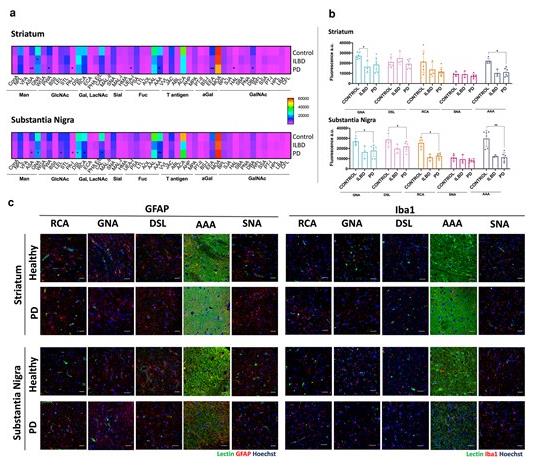The neuroinflammation associated with Parkinson’s disease (PD) has attracted widespread attention due to abnormal protein aggregation, among which glycosylation, as a post-translational modification process that maintains protein stability, plays an important role in this process.
Recently, in a research report published in the international journal PNAS Nexus titled ” Changes in tissue protein N-glycosylation and associated molecular signature occur in the human Parkinsonian brain in a region-specific manner”, scientists from institutions such as the University of Galway identified for the first time key targets in the molecular characteristics of Parkinson’s disease at different stages of progression through their research.
Our Featured Products
| Cat.No. | Product Name | Source | Species |
| Lectin-3931A | Active Native Allium sativum Lectin Protein, Alkaline Phosphatase Conjugated | Allium sativum | Allium sativum |
| Lectin-3988C | Active Native Calystega sepiem Lectin Protein, Alkaline Phosphatase Conjugated | Calystega sepiem | Calystega sepiem |
| Lectin-4017C | Active Native Cicer arietinum Lectin Protein, Alkaline Phosphatase Conjugated | Cicer arietinum | Cicer arietinum |
| Lectin-4046D | Active Native Dioclea grandiflora Lectin Protein, Alkaline Phosphatase Conjugated | Dioclea grandiflora | Dioclea grandiflora |
| Lectin-4064E | Active Native Euonymus europaeus Lectin Protein, Alkaline Phosphatase Conjugated | Euonymus europaeus | Euonymus europaeus |
| Lectin-4212M | Active Native Morniga M Lectin Protein, Alkaline Phosphatase Conjugated | Morniga M | Morniga M |
Currently, there are over 10 million Parkinson’s disease patients worldwide, making it the second most common neurodegenerative disease in the world after Alzheimer’s disease. However, scientists still know very little about the complete molecular characteristics of Parkinson’s disease, especially due to its complexity and limitations in analytical tools. Analyzing polysaccharide molecules closely related to the disease is a daunting challenge for the scientific community. These polysaccharides are located on the surface of cell membranes and are core elements that ensure accurate information transmission between cells. They participate in and regulate intercellular communication by interacting with other molecules such as lipids and proteins.

In this groundbreaking study, researchers comprehensively described the changes in brain region-specific glycans and their associated molecular markers under the influence of Parkinson’s disease. This discovery may lead scientists to develop therapeutic methods targeting polysaccharides, thereby achieving effective treatment and diagnosis of human Parkinson’s disease. Professor Abhay Pandit pointed out that the content presented in this study provides valuable information for the scientific community to further explore the impact of polysaccharides in the brain on neurodegenerative diseases. Now, we have made it clear that the modification of polysaccharides may have chain effects on other physiological functions of the body, and may even accelerate the process of decline.

Researchers have paid special attention and research to Parkinson’s disease, but the polysaccharide environment in other human neurodegenerative diseases has not been thoroughly studied. Therefore, this study may lay a certain foundation for further research on other diseases by scientists in the future. Researcher Ana Lucia Rebelo said that in this study, they aimed to specifically investigate the previously unexplored aspect of the brain in Parkinson’s disease patients – the glycome; Moreover, this study is an important step towards gaining a deeper understanding of this disease that alters human life, and is also a crucial step in exploring therapeutic strategies that target changes that previously could not be explained.
The emerging technologies currently under development may help expand the preliminary “sugar” characterization initiated in this study, and are expected to continuously drive research in this field in future studies. In summary, the research results of this article indicate that the complete characterization of the N-glycans in the human substantia nigra and striatum by researchers may provide a deeper understanding of the proteomics of Parkinson’s disease through a horizontal approach, while also combining with other “omics” fragments of Parkinson’s disease for further research. This may potentially help develop new therapies with a focus on glycans.
Related Products and Services
Parkinson’s Disease Related Molecules
Protein Glycosylation Labeling Service
Protein Expression and Purification Services
Reference
Ana Lúcia Rebelo, Richard R Drake, Martina Marchetti-Deschmann, et al. Changes in tissue protein N-glycosylation and associated molecular signature occur in the human Parkinsonian brain in a region-specific manner, PNAS Nexus (2023). DOI:10.1093/pnasnexus/pgad439